Chicano Art With Skulls and Day of the Dead
El Día de los Muertos, or the Day of the Dead, is a Mexican and Mexican American holiday celebrated on November 1st and 2nd, during which the graves of loved ones are decorated, special foods such every bit mole and pan de muerto are made, ofrendas (altars), are built to honor the dead, and special festivals and processions are held.
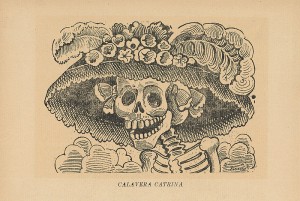
José Guadalupe Posada, La Calavera Catrina, 1913
The 24-hour interval of the Dead has its origins in ancient Mesoamerican cultures that blended with those of the Spaniards who arrived in Mexico in the early on 1500s. During the early on 20th century, Mexican artist José Guadalupe Posada popularized the skeleton images – the calaveras – associated with the holiday, through his humorous drawings of calaveras, establishing a uniquely Mexican style of art.
During the 1960s and early 1970s, the Chicano Move embraced El Día de los Muertos as a manner to reconnect with pre-Hispanic and Mexican identities. Today, the Day of the Dead continues to be historic by Mexicans and Mexican Americans across Mexico and United States every November.
Common Practices for Day of the Dead
Day of the Dead is annually celebrated on November 1st and 2nd. The first twenty-four hours, called "Día de los Angelitos" (Day of the Trivial Angels), is dedicated to the souls of deceased children, while November 2nd is gear up aside for the souls of adults. In preparation for these days, families may clean their homes to welcome the arrival of the souls of their loved ones. Many people also visit cemeteries to decorate the graves of the dead with their favorite items and flowers.
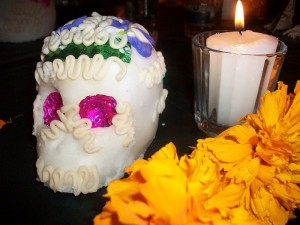
Cempasúchitl, Candle, and Calavera on Ofrenda
Graves and ofrendas are busy with papel picado, photographs, cherished objects, marigolds (cempasúchitl), and skeletons made of newspaper or clay. Food and drink are placed on the ofrendas for the dead – people commonly believe that they can notwithstanding bask the tastes and smells.
There are many important foods associated with Day of the Expressionless. The main dish is typically mole, which consists of meat (usually chicken or pork) cooked with a sauce made from chilies, chocolate, peanuts, and other ingredients that vary by region. Pumpkin candies, rice pudding, and tamales may also be offered. Bakeries produce special bread called pan de muerto (bread of the dead) in the shape of people or bones, busy with pink or colorful saccharide. Candy stores likewise sell skulls made of sugar or chocolate, adorned with names, for both children and adults to enjoy.
Skeleton / Calavera Imagery in Printmaking
Various artists who have done their residency at the Serie Project have made their own interpretations of the Day of the Dead tradition and its meaning in their screen prints. Below are three examples.
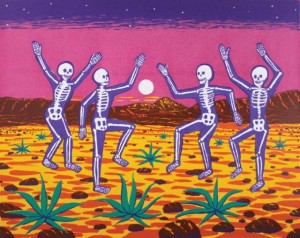
David Martinez, Fiesta de las Calacas, 2005
David Martinez (Serie 2)
Fiesta de las Calacas , 1995
Screen Print
Edition of 30
Not for auction
Austin artist David Martinez began painting canvases in his mid-forties, after expressing himself through diverse kinds of craft work. He has followed the ideals of tribal people in his life and art, which is genuinely affected by indigenous cultures immersed in nature and art. Martinez's slice, Fiesta de las Calacas illustrates a story virtually four ghosts who have a reunion political party every year when the moon is total on the night of the Day of the Dead. Characters fling their bones into a tight dance and sing their fate to the empty desert.
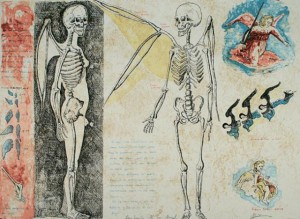
Aldo Valdez Bohm, Anatomia de united nations angel, 2002
Aldo Valdez Bohm (Serie IX)
Anatomia de un angel, 2002
Screen Impress
Edition of 50
Click here to buy
Aldo Valdez Bohm earned his Bachelor of Fine art degree at Southwestern University in Georgetown, Texas, focusing on sculpture and ceramics. Valdez Bohm explains that this is function of a body of piece of work in which he explores the skeletal anatomy. Reflecting on the imagery from the Italian Renaissance composition of angels, Bohm is hoping to "understand" the physical attribute of angels.
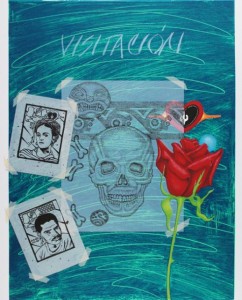
Rudy Fernandez, Visitation: Modern Heroes, 2004
Rudy Fernandez (Serie XII)
Visitation: Modern Heroes, 2004
Screen Print
Edition of 50
Click here to purchase
Rudy Fernandez is a sculptor and visual artist, currently living in Dallas, Texas. He received his BFA from Academy of Colorado, Boulder, and his MFA from Washington State University in sculpture and painting. He often works in mixed mediums to create three-dimensional gimmicky altars, using elements and symbols associated with organized religion and Latino civilisation such as roses, hearts, skulls, etc. His work is vibrant and full of life. Visitation: Modern Heroes is a memorial for his deceased blood brother. It also includes a motion picture of Frida Kahlo, and various other elements that create a collage of memories and color.
Source: https://serieproject.org/dia-de-los-muertos-day-of-the-dead-art-traditions/
0 Response to "Chicano Art With Skulls and Day of the Dead"
Post a Comment